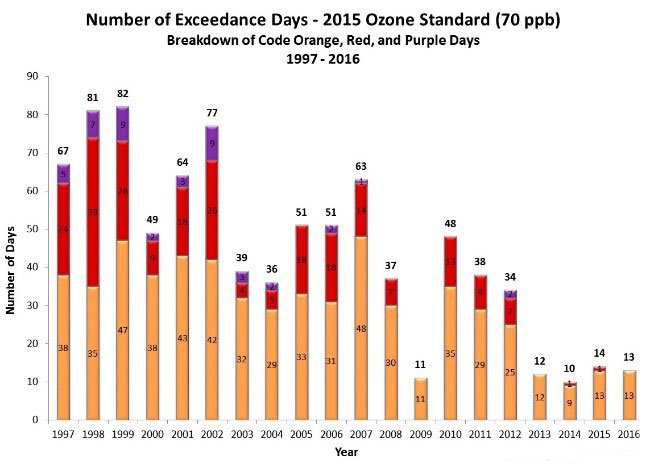Although we’ve enjoyed many air quality improvements in metropolitan Washington over the last decade, it is important to remember that there is much more work to be done. Work that needs the support of the federal government, but also state and local governments, businesses, and residents across our region.
Metropolitan Washington has made significant progress fighting air pollution, reducing bad air days from 77 on average from the mid-1990’s to just 12 on average over the past few years. This is thanks to more than a decade of action at the federal, state, and local government levels to reduce emissions from power plants, passenger vehicles, and heavy duty diesel engines as well as programs to improve energy efficiency and renewable energy use.

The proposed 2015 standard, which aims at better protecting public health, is more stringent than the current 2008 standard. The region has not had a Code Red Day for the past four years under the current standard.
Despite this good news, air quality monitors show that people in our region continue to breathe unhealthy air due to ground-level ozone. We have already measured one Code Orange day this spring. Sensitive groups, including children, people with respiratory and heart conditions, older adults, and people who are active outdoors may experience health effects and should limit time spent outside on these bad air days.
The new Administration has announced it is studying whether to roll back the latest air quality standard for ozone. Its proposed budget, for fiscal year 2018, also includes reducing the Environmental Protection Agency’s (EPA) funding by more than 30 percent.
This most recent federal ozone standard—released in 2015—that’s under review is an important piece in the long-term efforts to protect human health and the environment locally and nationwide; the standard is meant to significantly reduce ozone pollution and decrease people’s exposure in their daily activities. In addition, the administration’s proposed budget cuts would reduce or eliminate federal programs such as state grants for air programs, the Diesel Emission Reduction Act, and the Clean Power Plan. These programs help reduce emissions that cause unhealthy air, particularly on the warmest days of spring and summer when our air quality can be worse.
Since pollution is transported into our region, it is imperative that the EPA continue their national strategy to address pollution, by working with the states and local governments to meet the current standard, and by providing assistance and enforcing rules. This is especially important as it relates to pollution that does not originate locally; we can be affected by air pollution that’s generated upwind of our region.
We must remain dedicated to taking actions to have good air quality, or Code Green, every day across our region. As chairman of the Metropolitan Washington Air Quality Committee, I am committed to working alongside my regional colleagues to reach this goal.
Each of us can also do our part to improve the air we breathe. Keep driving to a minimum, use transit, telework, or carpool, turn off lights and electronics when not in use, follow tips from your electric utility about how to use less electricity and keep your house cool, and postpone lawn mowing or use an electric mower and fill your vehicles' gas tanks after dark on poor air quality days.
We must continue to work together to meet the federal health standards, further reduce ozone levels, and protect the health of our residents. Everyone needs clean air to breathe easy.
Hans Riemer is Vice President of the Montgomery County Council and is serving as Chairman of the Metropolitan Washington Air Quality Committee at COG.